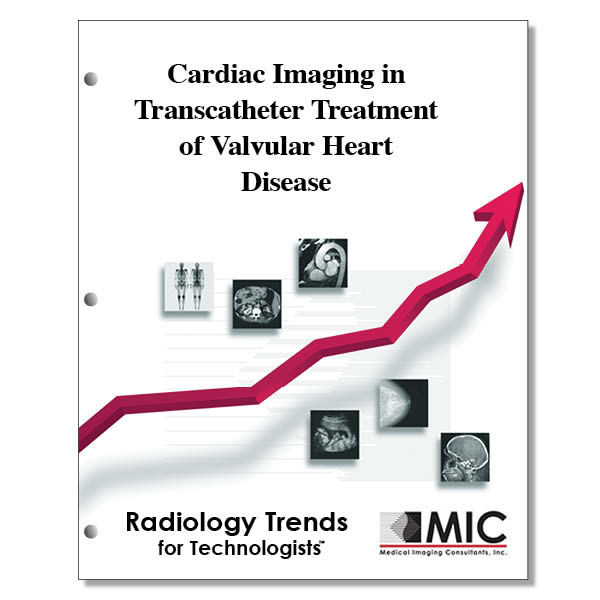

Cardiac Imaging in Transcatheter Treatment of Valvular Heart Disease
Given the increase in catheter-based techniques for the treatment of structural heart disease, this review highlights the key role of multi-modality imaging for preprocedural planning, intraprocedural monitoring, and postprocedural follow-up for these cases.
Course ID: Q00704 Category: Radiology Trends for Technologists Modalities: Cardiac Interventional, CT, MRI2.00 |
Satisfaction Guarantee |
$24.00
- Targeted CE
- Outline
- Objectives
Targeted CE per ARRT’s Discipline, Category, and Subcategory classification:
[Note: Discipline-specific Targeted CE credits may be less than the total Category A credits approved for this course.]
Cardiac-Interventional Radiography: 1.75
Procedures: 1.75
Interventional Procedures: 1.75
Computed Tomography: 1.00
Procedures: 1.00
Neck and Chest: 1.00
Registered Radiologist Assistant: 1.75
Procedures: 1.75
Thoracic Section: 1.75
Outline
- Introduction
- Transcatheter Aortic Valve Replacement
- Annulus
- Aortic Root
- Aortic Valve Morphologic Characterisitcs
- Calcium Distribution
- Additional Anatomic Measurements for TAVR
- Catheter Access Route
- Transcatheter Mitral Valve Repair
- Transcatheter Mitral Valve Replacement
- Mitral Valve Evaluation before Transcatheter Replacement
- Neo-LVOT Characterization and Risk of LVOT Obstruction
- Transcatheter Tricuspid Valve Interventions
- Novel Cardiovascular Imaging Techniques
- Conclusion
Objectives
Upon completion of this course, students will:
- be familiar with the key roles for multimodality imaging in the diagnosis and treatment of both coronary and structural heart disease
- be familiar with the commonality of aortic valve stenosis
- recognize the imaging modality of choice for preprocedural TAVR planning
- recognize the measured parameters at CT angiography at the level of the aortic root
- be familiar with the imaging-derived predictive factor for annular rupture in TAVR
- be familiar with the approved transcatheter aortic replacement devices
- be familiar with the measurements associated with a higher risk of coronary artery occlusion
- identify the first diagnostic test obtained in the assessment of valvular disease
- be familiar with the classifying factors for bicuspid morphology
- be familiar with the clinical trials conducted on TAVR outcomes
- understand the benefits of using optimal fluoroscopic projection while performing TAVR
- identify the artery typically used for performing TAVR
- identify the CE-approved transcatheter mitral valve repair devices
- recognize the FDA-approved transcatheter mitral valve repair device
- be familiar with the indirect devices used for mitral valve repair
- be familiar with the utilization of Cardioband for mitral valve repair
- identify the views necessary for preprocedural cardiac CT assessment of the mitral valve apparatus for planning percutaneous edge-to-edge repair
- be familiar with the use of MitraClip
- identify the CT artifacts in the setting of annular calcification
- be familiar with the acronym of TMVR
- be familiar with the D-shape annulus image used for TMVR
- be familiar with the scoring system developed by Guerrero et al
- recognize the risks associated with LVOT obstruction
- be familiar with the projected area measurements associated with high risk LVOT obstruction
- be familiar with the use of transthoracic echocardiography for repair or replacement of the tricuspid valve
- be familiar with the criteria for assessing tricuspid regurgitation
- identify valuable CT information used for planning tricuspid valve interventions
- be familiar with the predicted anchor position in CT imaging
- be familiar with the dynamic imaging factors for measuring the tricuspid annulus
- be familiar with advanced visualization techniques for imaging structural heart disease
- recognize the main imaging modalities used for assessments for structural heart interventions
- be familiar with the characteristics of virtual reality
- be familiar with the potential advantages of 4D imaging
- be familiar with the algorithms that will potentially improve accuracy and reliability of image-based diagnosis
- be familiar with the use of mixed reality imaging
